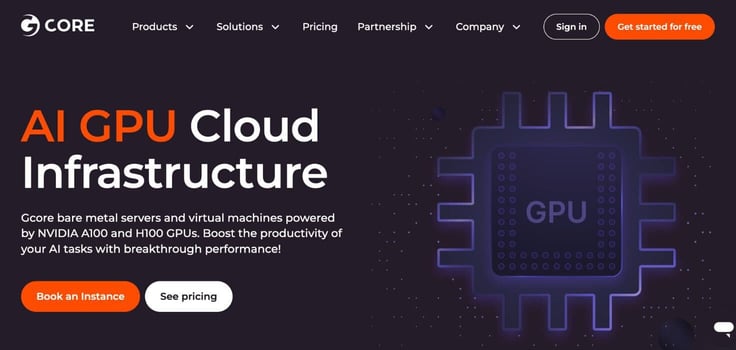
TL; DR: Gcore is a global AI infrastructure provider that supplies companies with the resources to train models faster and reduce latency. Its platform combines security, computing power, and edge networking to create a comprehensive solution to help users along the complete AI development life cycle. We spoke with Seva Vayner, Product Director of Edge Cloud and AI at Gcore, about the platform’s differentiators, the edge’s impact on applications, and AI’s future.
AI has officially arrived as the Next Big Thing, following in the footsteps of fellow trailblazing technologies, including smartphones and the cloud. These technologies have already reshaped the world as we know it and have helped lead us deeper into the age of digital transformation. Inventions, such as ChatGPT, are just the beginning for AI.
AI adoption has increased quickly, and the train doesn’t seem to be stopping anytime soon. More than 80% of companies have adopted AI in some way, according to The Social Sheperd, and most of these companies have prioritized it in their business strategy.
It’s no secret companies are racing to create their own AI solutions. The versatility and power of AI make it a valuable asset to any industry. AI integration can look like anything from a chatbot assistant to autopilot in cars. But before anyone can start their AI journey, they need resources to build, train, and infer models. This is where Gcore comes in.

“We provide different accelerators to accommodate customers’ needs and requirements, from storing the datasets to training the models and inferencing the models on the edge,” said Seva Vayner, Product Director of Edge Cloud and AI at Gcore.
Gcore has positioned itself as a global AI infrastructure provider to help businesses streamline the entire AI life cycle on the edge. Seva said Gcore has three main layers: compute power, network, and security. The team delivers all these layers to ensure customers receive pure edge inference and real-time processing worldwide.
Gcore Provides Mission-Critical Infrastructure for AI Training
Gcore began its journey 10 years ago as a CDN and hosting provider. Its background allowed it to build the expertise and infrastructure it needed to become what it is today. Seva said Gcore decided to pivot to AI infrastructure in 2022 and partnered with Graphcore to do so.
“We started as a CDN. Shortly after that, we transformed into a full infrastructure provider with all infrastructure capabilities, including compute power, security, and networks,” said Seva.
Gcore now offers GPU and IPU cloud infrastructure to help users build AI solutions. With its accelerator offerings, companies can go to market faster and accomplish various use cases, from fine-tuning smaller models to training large language models.

“We provide very powerful NVIDIA A100 and H100 GPUS for customers working on generative AI, large language models, and NLP projects where you need big compute power to train those models,” said Seva.
Gcore also provides fast and reliable storage for data. Data security is one of the top features SMBs and enterprises look for when coming to Gcore because data is so crucial for AI training. Users can connect their storage to their AI clusters for training or fine-tuning their models.
“We also provide integration with the MLOps platforms to provide an easy tooling workspace for ML engineers and data scientists who can use the integration to focus on the ML code and training their models,” said Seva.
How Adopting Edge Computing Can Positively Impact Industries
One of Gcore’s main highlights is its edge network. Spanning more than 160 points of presence, Gcore’s robust and efficient edge solution helps companies reduce latency for their applications, no matter where in the world they or their customers are located.
The edge takes AI solutions to the next level by helping customers run their models more smoothly and gain better availability. And it can be valuable for various industries. Seva highlighted several industries that could benefit from edge adoption, including automotive, healthcare, gaming, and social media.
“We are working with automotive companies focusing on autopilot and autonomous driving. We see a big potential for inference at the edge where companies need vast numbers of points of presence to optimize for latency because autopilot needs to process data in milliseconds or less,” said Seva.
Gaming is another industry that has booming AI adoption. As games accommodate more players and become more resource-intensive, companies will have to ensure performance meets those requirements and user expectations. Gamers want to avoid lagging, so implementing edge solutions can help reduce the latency that comes with high-population and AI-based games.
“We started with gaming because it was the first industry that required such low latency. But since then, many more industries have moved to the digital sphere and are trying to deliver content with low latency to end users,” said Seva.
With edge networks, businesses don’t have to worry about server location and its impact on performance. “The world will soon move into real-time interaction and processing. This makes the edge critical, and Gcore is ready to bring the edge to everyone.,” said Seva.
Gcore Delivers Faster Time to Market and Optimization
Gcore built a global network and infrastructure to help companies create AI solutions faster and at the edge. Its edge solutions allow companies to achieve their primary goal, lower latency, so they can distribute content as quickly as possible without any performance hiccups.
“Right now, the trend is to use a large quantity of GPUs to train models fast, because time to market is essential for every business in such a fast-moving industry,” said Seva.
Gcore’s integrated platform enables teams to be agile in an ever-changing tech landscape. It covers security, networking, and cloud computing, which are all essential pieces to the AI development life cycle. This way, companies can have all they need to optimize their AI solution and accelerate development.
“I hope that in the coming years, the trend will be towards performance and optimization. At Gcore, we’re already set up to provide the infrastructure companies need to achieve those goals,” said Seva.
As for releases to look forward to, Gcore is currently working on a solution for inference at the edge, which will release in Q1 of 2024. “We will distribute trained models around the globe and use our capabilities to optimize the first latency connection between the end user and our infrastructure. It will route traffic for processing customer requests to optimize output talk-ins to the nearest inference nodes,” said Seva.


